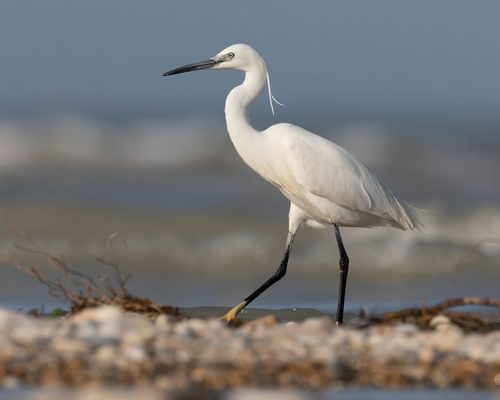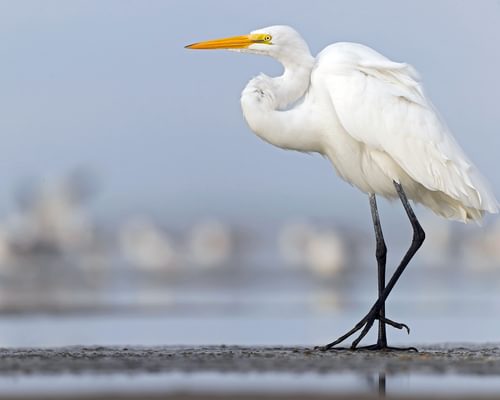Cattle Egret
Least ConcernBubulcus ibis
Visual Identification
Appearance
The Cattle Egret is a compact, white heron with a robust yellow bill and yellowish-black legs. During the breeding season, adults develop buff-colored plumes on their heads, necks, and backs, giving them a golden glow.
Non-breeding adults and juveniles are entirely white. The species shows no significant sexual dimorphism, with males and females appearing nearly identical. Females are usually smaller, however.
Size
Length
46cm to 56cm
Wingspan
88cm to 96cm
Weight
270g to 512g
Colours
Males and females have similar plumage
Primary Colour
White
Secondary Colour
Buff
Beak Colour
Yellow Orange
Leg Colour
Yellow Black
Habitat and Distribution
Habitats
Woodland
Garden
Wetland
Coastal
Urban
Farmland
Grassland
Desert
Tundra
Rainforest
Mountain
Savanna
Distribution
Cattle Egrets inhabit many open habitats, including pastures, wetlands, and agricultural lands. They're found across six continents, with significant populations in Africa, Asia, Australia, and the Americas.
They're common in the southern United States and parts of Australia and have established populations in the UK. Their distribution can vary seasonally, with some populations undertaking short-distance migrations.
Elevation Range
Up to 4,000 meters
Climate zones
Tropical, Subtropical, Temperate
Distribution Map
This map gives you a rough idea of where you might spot a Cattle Egret. The coloured areas show countries where these birds have been seen.
A few things to keep in mind:
- Birds might not be everywhere in the coloured areas, for example, they may be present around the coast of that country
- Where birds live can change with seasons and available food
- This map is quite simple - it doesn't show exact locations
We're working on making our maps even better! Soon, we hope to show you:
- More detailed maps for bigger countries, including state and region
- How birds move around during different seasons
Distribution by Region
Behaviour and Ecology
Bird Attributes
This feature is in beta. We'd love your feedback to improve it!
Share your thoughtsBird Attributes Explained
Our bird attributes system rates various aspects of a bird's capabilities on a scale of 0-100, based on data from field observations, scientific studies, and expert knowledge.
Attribute Categories:
- Agility: Manoeuvrability, speed, and grace in flight or movement.
- Strength: Physical power, often correlating with size and hunting abilities.
- Adaptability: Ability to thrive in various environments or changing conditions.
- Aggressiveness: Territorial behaviour and assertiveness, particularly during breeding seasons.
- Endurance: Stamina, often seen in migration patterns or foraging behaviours.
Understanding the Ratings:
- 0-20: Very Low
- 21-40: Low
- 41-60: Average
- 61-80: High
- 81-100: Very High
Remember, these attributes are relative to other bird species and don't necessarily indicate superiority.
Hover over the icon next to each attribute for more information.
Tap the icon next to each attribute for more information.
Agility
Reflects the bird's manoeuvrability, speed, and grace in flight or movement.
The Cattle Egret displays considerable agility in its foraging behaviour, adeptly manoeuvring around large animals to catch disturbed insects. Their ability to snatch flies and ticks directly off mammals demonstrates impressive dexterity.
Strength
Indicates the bird's physical power, often correlating with size and hunting abilities.
While not exceptionally strong for their size, Cattle Egrets possess enough strength to construct sturdy nests and handle a variety of prey, including small vertebrates like frogs and lizards.
Adaptability
Represents the bird's ability to thrive in various environments or changing conditions.
Cattle Egrets are highly adaptable, having spread to six continents in just over a century. Their ability to thrive in diverse habitats, from wetlands to farmlands, and their opportunistic feeding strategy showcase remarkable adaptability.
Aggressiveness
Measures the bird's territorial behaviour and assertiveness, particularly during breeding seasons.
Generally non-aggressive towards other species, Cattle Egrets are social birds often seen in large flocks. However, they may display some aggression during breeding season or when defending nesting sites.
Endurance
Reflects the bird's stamina, often seen in migration patterns or foraging behaviours.
Cattle Egrets demonstrate good endurance, capable of consuming up to 50% of their body weight in insects daily. Their ability to undertake short-distance migrations and maintain activity throughout the day in various climates indicates strong endurance.
Diet
Cattle Egrets primarily feed on insects, particularly grasshoppers, crickets, and flies. They also consume small vertebrates like frogs, lizards, and even fish.
Their unique foraging behavior of following large animals allows them to catch prey flushed out by their 'hosts' movement, as well as taking flies and ticks directly off the animals’ bodies to the benefit of both.
They will also scavenge for scraps around areas of human occupation.
Behaviour
Cattle Egrets are highly social and often seen in large flocks. They're known for their commensal relationship with large grazing mammals, following them to catch disturbed insects.
These birds are also adept at catching flies and ticks directly off animals, showcasing their opportunistic feeding strategy.
Vocalisation
Nesting & Breeding
Cattle Egrets typically breed in colonies, often with other heron species. Pair formation begins with elaborate courtship displays, including neck stretching and feather fluffing.
Nests are platform-like structures made of sticks, built in trees or shrubs near water. Females lay 2-5 pale blue eggs, which both parents incubate.
Incubation lasts about 23 days, with chicks fledging after 30-45 days. Parents continue to feed the young for several weeks after they leave the nest.
Lifespan
The Cattle Egret typically lives for 7 to 10 years, with a maximum recorded lifespan of 23 years.
Like all birds, lifespan can be affected by factors including predation, habitat quality, disease, and access to food sources.
Conservation and Status
Global Conservation Status
While the Cattle Egret is listed as Least Concern due to its vast range and increasing population, it faces localized threats from habitat loss and agricultural changes.
Conservation efforts focus on protecting wetlands and maintaining traditional farming practices that benefit the species.
Birdwatching Tips
- Look for white birds following cattle or other large animals in pastures
- Observe their distinctive 'hunched' posture when perched
- During the breeding season, watch for the golden buff coloration on the head and back
- Check wetland edges and shallow ponds where they often gather
Additional Information
Quick Facts
Other names:
Buff-backed Heron, Cow Crane, Western Cattle Egret
Family:
ArdeidaePredators
Did You Know?
- Cattle Egrets have spread to six continents in just over a century, one of the most rapid and wide-reaching natural expansions of any bird species.
- They can eat up to 50% of their body weight in insects daily, making them valuable allies in pest control.
- Despite their name, Cattle Egrets are associated with many large animals, including elephants, rhinos, and farm machinery.
Was this bird profile helpful?
Your feedback helps us improve our content
Thanks for your feedback!
Your input helps us improve our content.
Community Experience
Community Ratings
No ratings yet - be the first to rate this bird!
Latest Community Reviews
No reviews yet
Sign in to be the first to review
Community Reviews
Create Your Free Account Welcome Back!
Join our community to rate birds and share your experiences. Creating an account is completely free and only takes a minute. Sign in to your account to rate birds and share your experiences with our community.
Your information is secure and will never be shared.
By creating an account, you agree to our Privacy Policy.
FAQs
The sub-species debate
Whilst it is recognised generally that there are two sub-species of the cattle egret, split by geographical habitat and plumage characteristics, some ornithologists are of the opinion that the western variety and eastern variety are in fact two separate species. In the main however, it is accepted that both the western and eastern birds fall within the Bubulcus ibis species.
Confusion arises with a third dissident sub-species known as Bubulcus ibis seychellarum, which inhabits the Seychelles archipelago in the Indian Ocean. Whilst the jury is still out, although this latter egret is smaller in stature than the nominate sub-species, the western variety, it is widely recognised as being a member of that sub-species (Bubulcus ibis ibis).
Similar Birds
References
- 2
website: BirdLife International. 2019. Bubulcus ibis (amended version of 2016 assessment). The IUCN Red List of Threatened Species 2019: e.T22697109A155477521.
View source - 4
report, 2015: Wetlands International
- 3
website, 2015: BirdLife International
View source - 1
website, 2000: Carey and Judge, Longevity Records: Life Spans of Mammals, Birds, Amphibians, Reptiles, and Fish
View source

